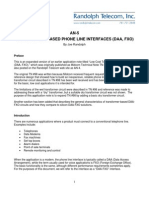Lab06 - Controlling A Servo Motor Using Arduino
Uploaded by
agcaoilimarkrLab06 - Controlling A Servo Motor Using Arduino
Uploaded by
agcaoilimarkrLaboratory Activity #6
Controlling a Servo Motor
Name: ______________________________________ C/Y/S: ____________ Date Submitted: _______________________
Objectives:
▪ To control a Servo Motor using Arduino programming.
Introduction:
A Servo Motor is a small device that has an output shaft. This shaft can be positioned to specific angular positions by sending
the servo a coded signal. If the coded signal exists on the input line, the servo will maintain the angular position of the shaft. If the coded
signal changes, the angular position of the shaft changes. In practice, servos are used in radio-controlled airplanes to position control
surfaces like the elevators and rudders. They are also used in radio-controlled cars, puppets, and of course, robots.
Figure 1. A Servo Motor
Servos are extremely useful in robotics. The motors are small, have built-in control circuitry, and are extremely powerful for
their size. A standard servo such as the Futaba S-148 has 42 oz/inches of torque, which is strong for its size. It also draws power
proportional to the mechanical load. A lightly loaded servo, therefore, does not consume much energy.
The guts of a servo motor is shown in the following picture. You can see the control circuitry, the motor, a set of gears, and the
case. You can also see the 3 wires that connect to the outside world. One is for power (+5volts), ground, and the white wire is the
control wire.
Figure 2. Internal of a Servo Motor
Digital Electronics 2: Microprocessors and Microcontrollers
Darwin D. Mañaga, Meng-ECE, PECE, ACPE
Reference:
https://www.tutorialspoint.com/arduino/arduino_servo_motor.htm
Working of a Servo Motor
The servo motor has some control circuits and a potentiometer (a variable resistor, aka pot) connected to the output shaft. In
the picture above, the pot can be seen on the right side of the circuit board. This pot allows the control circuitry to monitor the current
angle of the servo motor.
If the shaft is at the correct angle, then the motor shuts off. If the circuit finds that the angle is not correct, it will turn the motor
until it is at a desired angle. The output shaft of the servo can travel somewhere around 180 degrees. Usually, it is somewhere in the
210-degree range, however, it varies depending on the manufacturer. A normal servo is used to control an angular motion of 0 to 180
degrees. It is mechanically not capable of turning any farther due to a mechanical stop built on to the main output gear.
The power applied to the motor is proportional to the distance it needs to travel. So, if the shaft needs to turn a large distance,
the motor will run at full speed. If it needs to turn only a small amount, the motor will run at a slower speed. This is called proportional
control.
How Do You Communicate the Angle at Which the Servo Should Turn?
The control wire is used to communicate the angle. The angle is determined by the duration of a pulse that is applied to the
control wire. This is called Pulse Coded Modulation. The servo expects to see a pulse every 20 milliseconds (.02 seconds). The length
of the pulse will determine how far the motor turns. A 1.5 millisecond pulse, for example, will make the motor turn to the 90-degree
position (often called as the neutral position). If the pulse is shorter than 1.5 milliseconds, then the motor will turn the shaft closer to 0
degrees. If the pulse is longer than 1.5 milliseconds, the shaft turns closer to 180 degrees.
Figure 3. Working of a Servo Motor
Digital Electronics 2: Microprocessors and Microcontrollers
Darwin D. Mañaga, Meng-ECE, PECE, ACPE
Reference:
https://www.tutorialspoint.com/arduino/arduino_servo_motor.htm
Components Required:
You will need the following components −
1 × Arduino UNO board
1 × Servo Motor
1 × ULN2003 driving IC
1 × 10 KΩ Resistor
Procedure
Follow the circuit diagram and make the connections as shown in the image given below.
Figure 4. Schematic Diagram
Digital Electronics 2: Microprocessors and Microcontrollers
Darwin D. Mañaga, Meng-ECE, PECE, ACPE
Reference:
https://www.tutorialspoint.com/arduino/arduino_servo_motor.htm
Sketch
Open the Arduino IDE software on your computer. Coding in the Arduino language will control your circuit. Open a new sketch File by
clicking on New.
Arduino Code
/* Controlling a servo position using a potentiometer (variable resistor) */
#include <Servo.h>
Servo myservo; // create servo object to control a servo
int potpin = 0; // analog pin used to connect the potentiometer
int val; // variable to read the value from the analog pin
void setup() {
myservo.attach(9); // attaches the servo on pin 9 to the servo object
}
void loop() {
val = analogRead(potpin);
// reads the value of the potentiometer (value between 0 and 1023)
val = map(val, 0, 1023, 0, 180);
// scale it to use it with the servo (value between 0 and 180)
myservo.write(val); // sets the servo position according to the scaled value
delay(15);
}
Code to Note
Servo motors have three terminals - power, ground, and signal. The power wire is typically red and should be connected to the
5V pin on the Arduino. The ground wire is typically black or brown and should be connected to one terminal of ULN2003 IC (10 -16). To
protect your Arduino board from damage, you will need some driver IC to do that. Here we have used ULN2003 IC to drive the servo
motor. The signal pin is typically yellow or orange and should be connected to Arduino pin number 9.
Connecting the Potentiometer
A voltage divider/potential divider are resistors in a series circuit that scale the output voltage to a particular ratio of the input
voltage applied. Following is the circuit diagram −
Digital Electronics 2: Microprocessors and Microcontrollers
Darwin D. Mañaga, Meng-ECE, PECE, ACPE
Reference:
https://www.tutorialspoint.com/arduino/arduino_servo_motor.htm
Vout is the output potential, which depends on the applied input voltage (Vin) and resistors (R1 and R2) in the series. It means
that the current flowing through R1 will also flow through R2 without being divided. In the above equation, as the value of R2 changes,
the Vout scales accordingly with respect to the input voltage, Vin.
Typically, a potentiometer is a potential divider, which can scale the output voltage of the circuit based on the value of the
variable resistor, which is scaled using the knob. It has three pins: GND, Signal, and +5V as shown in the diagram below −
Figure 5. Potentiometer Pin Configuration
Expected Result
By changing the pot’s NOP position, servo motor will change its angle.
Digital Electronics 2: Microprocessors and Microcontrollers
Darwin D. Mañaga, Meng-ECE, PECE, ACPE
Reference:
https://www.tutorialspoint.com/arduino/arduino_servo_motor.htm
You might also like
- Module 3 Micro Controller and Motor ControlNo ratings yetModule 3 Micro Controller and Motor Control11 pages
- Electronic Basics #25: Servos and How To Use Them: Servo MotorNo ratings yetElectronic Basics #25: Servos and How To Use Them: Servo Motor13 pages
- Introduction To Servo Motors & Arduino PDFNo ratings yetIntroduction To Servo Motors & Arduino PDF6 pages
- How to Control Servo Motor Using ArduinoNo ratings yetHow to Control Servo Motor Using Arduino9 pages
- Experiment 5: Servo Motor Control Using ArduinoNo ratings yetExperiment 5: Servo Motor Control Using Arduino5 pages
- The University of Faisalabad: Experiment No.10No ratings yetThe University of Faisalabad: Experiment No.105 pages
- Whats A Servo?: (Click On Picture For Larger View)No ratings yetWhats A Servo?: (Click On Picture For Larger View)8 pages
- Design and Development of A Servo Control System For Arduino Uno Based Bird Drone MechanicsNo ratings yetDesign and Development of A Servo Control System For Arduino Uno Based Bird Drone Mechanics6 pages
- Interfacing Servo Motor With Arduino UnoNo ratings yetInterfacing Servo Motor With Arduino Uno11 pages
- Experiment No. 02: DR D Y Patil School of Engineering & TechnologyNo ratings yetExperiment No. 02: DR D Y Patil School of Engineering & Technology3 pages
- Experiment No. 02: DR D Y Patil School of Engineering & TechnologyNo ratings yetExperiment No. 02: DR D Y Patil School of Engineering & Technology3 pages
- Gyro Camera For Motorcycle Using ArduinoNo ratings yetGyro Camera For Motorcycle Using Arduino8 pages
- Reference Guide To Useful Electronic Circuits And Circuit Design Techniques - Part 1From EverandReference Guide To Useful Electronic Circuits And Circuit Design Techniques - Part 12.5/5 (3)
- Solar Powered Convenient Charging StatioNo ratings yetSolar Powered Convenient Charging Statio12 pages
- AnnexA 1 - List Documentary Requirements For Local PPP Projects FinalNo ratings yetAnnexA 1 - List Documentary Requirements For Local PPP Projects Final10 pages
- NM Laboratory 4 Roots of Linear Function Direct MethodsNo ratings yetNM Laboratory 4 Roots of Linear Function Direct Methods11 pages
- Generator Automatic Voltage Regulator Operation Manual100% (1)Generator Automatic Voltage Regulator Operation Manual9 pages
- Dual-Band Lumped-Element Bandpass Filter: Himanshu Joshi, Student Member, IEEE, and William J. Chappell, Member, IEEENo ratings yetDual-Band Lumped-Element Bandpass Filter: Himanshu Joshi, Student Member, IEEE, and William J. Chappell, Member, IEEE9 pages
- Irf7342Pbf: V - 55V R Max. 0.105 I - 3.4ANo ratings yetIrf7342Pbf: V - 55V R Max. 0.105 I - 3.4A8 pages
- An-5, Transformer-Based Phone Line Interfaces (DAA, FXO), Rev1No ratings yetAn-5, Transformer-Based Phone Line Interfaces (DAA, FXO), Rev115 pages
- Electrical Circuits Ii Direction: Read Each Item Carefully and Chose The BEST Answer From The Given Choices. Write Your100% (1)Electrical Circuits Ii Direction: Read Each Item Carefully and Chose The BEST Answer From The Given Choices. Write Your4 pages
- Operation and Installation For Sea Tel Model St24 Satellite TV Receive-Only Antenna100% (1)Operation and Installation For Sea Tel Model St24 Satellite TV Receive-Only Antenna101 pages
- Microcontroller Atmega8535 Programming and InterfacingNo ratings yetMicrocontroller Atmega8535 Programming and Interfacing8 pages
- Product Data: Charge Amplifier - Type 2635No ratings yetProduct Data: Charge Amplifier - Type 26354 pages

































































































